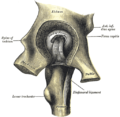This article includes a list of general references, but it lacks sufficient corresponding inline citations .(October 2021) |
| Anterior inferior iliac spine | |
|---|---|
 The obturator externus muscle (anterior inferior iliac spine visible in upper right) | |
 Right hip-joint from the front (anterior inferior iliac spine visible at upper left) | |
| Details | |
| Identifiers | |
| Latin | spina iliaca anterior inferior |
| TA98 | A02.5.01.112 |
| TA2 | 1328 |
| FMA | 63614 |
| Anatomical terms of bone | |
The anterior inferior iliac spine (AIIS) is a bony eminence on the anterior border of the hip bone, or, more precisely, the wing of the ilium.

